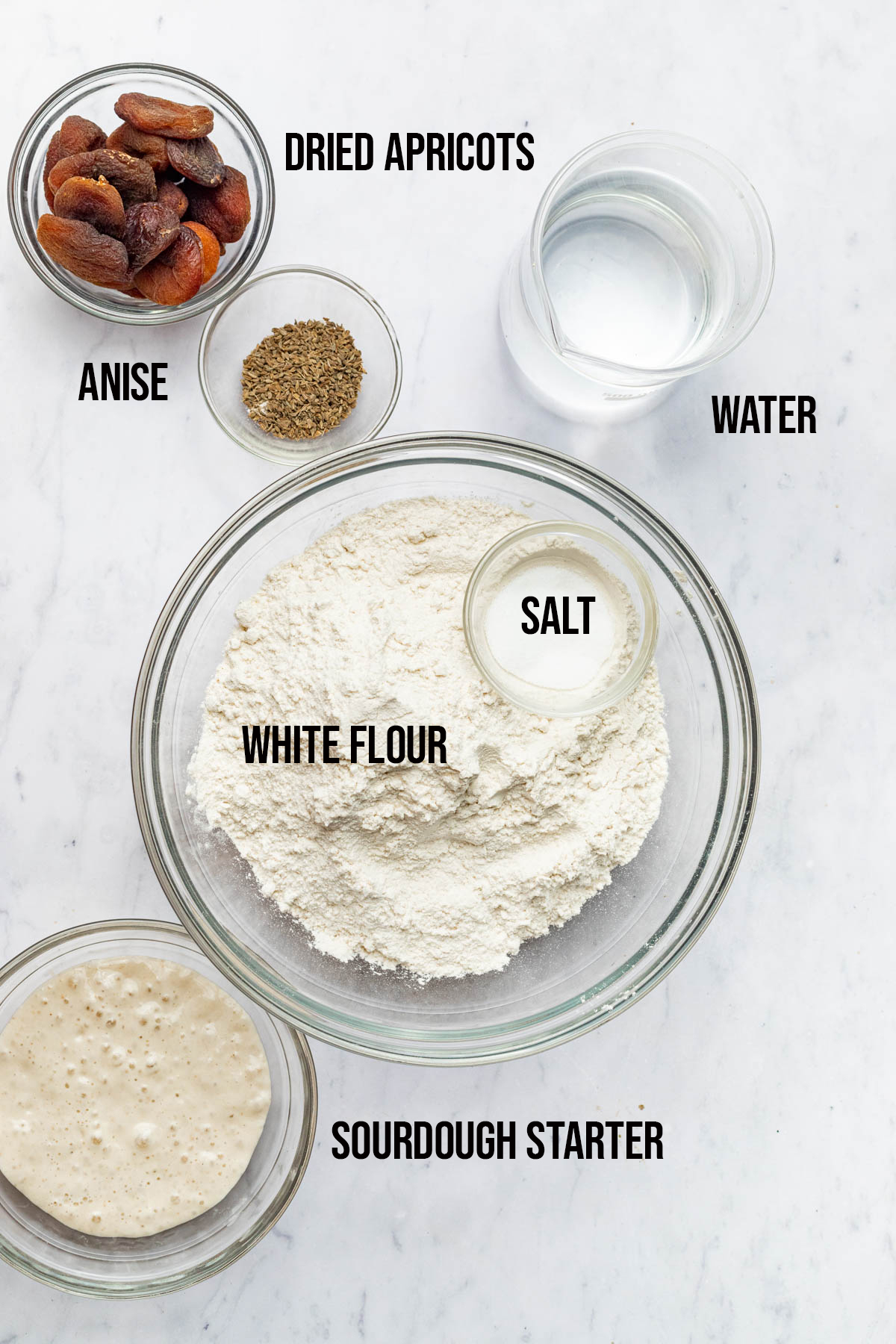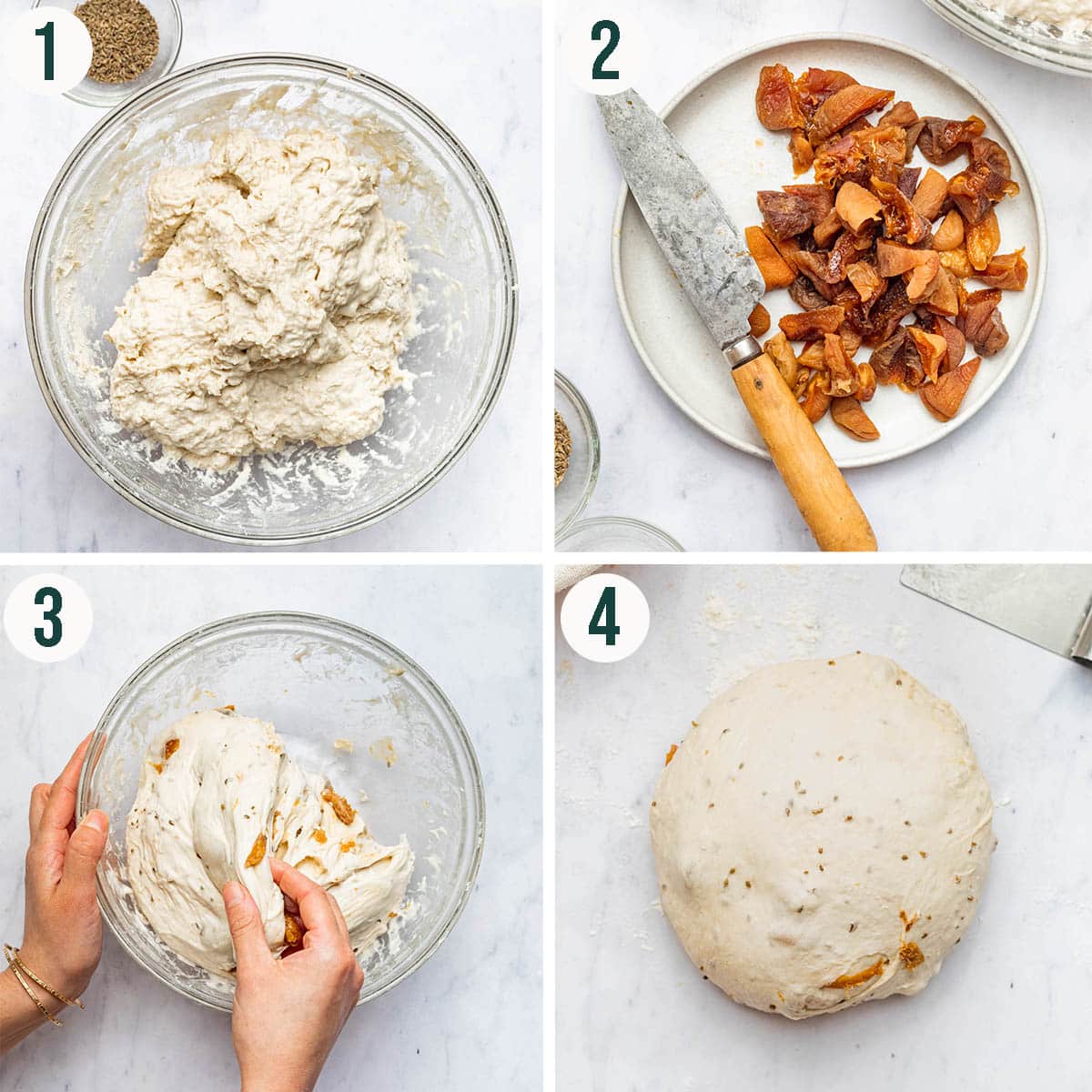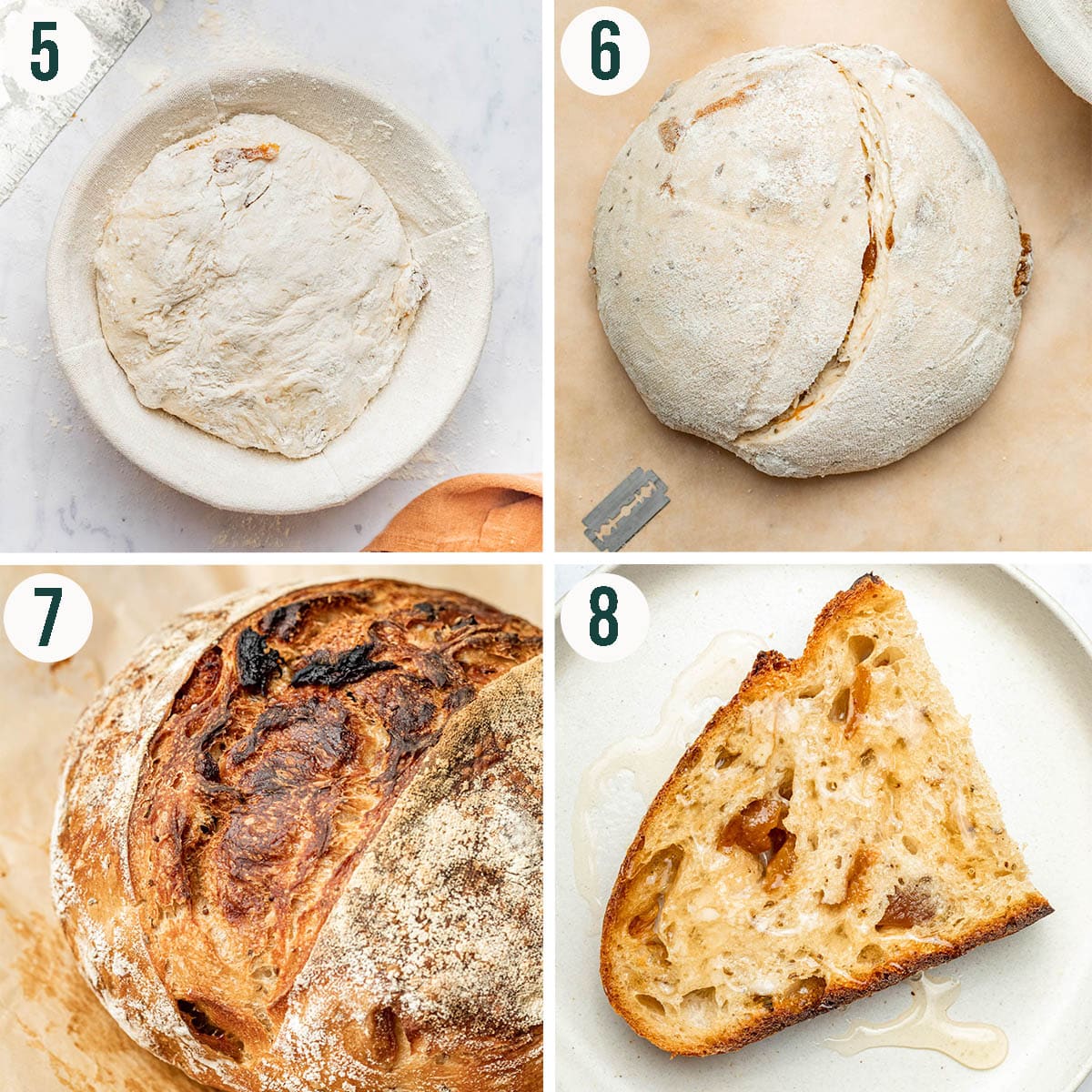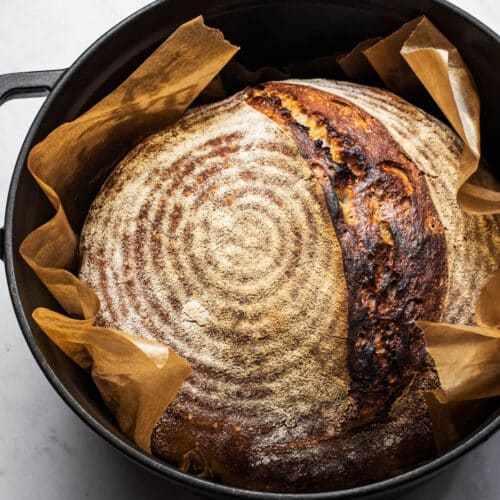A slightly sweet and herbal bread, this apricot sourdough bread features soaked dried apricots and liquorice aniseed. Made with plain flour rather than bread flour so it's a little less chewy and good for beginners.
If you love the idea of adding to your sourdough loaves, try our jalapeño cheddar sourdough, black pepper and rosemary sourdough bread, and walnut cranberry sourdough.

Jump to:
Ingredients

Ingredient Notes and Substitutions
- Apricots: we like unsulphured apricots because they have the best flavour. These are the darker coloured ones in the shops. Other dried fruit like plums, dates, or cranberries can be used in place of apricots. Still soak them beforehand.
- Anise seed: if you don't like anise flavour, use another spice like cumin. If you still want that hint of liquorice, use another similar spice like nigella seeds.
- Flour: to make a slightly more wholesome bread, use up to 40% whole wheat flour.
- Starter: an equal weight of levain can be used 1:1 in place of the active starter. It should be 100% hydration.
Method

Step 1: mix the water and starter, then mix in the flour to make a shaggy dough. Set aside to autolyse.
Step 2: while the dough is resting, soak and then chop the apricots.
Step 3: mix the salt into the dough, then add the apricots and anise. Do six rounds of stretches and folds.
Step 4: shape the dough into a boule.

Step 5: place the dough seam-side up into a prepared banneton.
Step 6: transfer the loaf to the fridge to rest overnight. In the morning, score the loaf.
Step 7: bake the bread in a preheated dutch oven.
Step 8: cool fully before slicing and serving.
Top Tips
- Understand the basics: If you need some general help, check out our guide on troubleshooting sourdough bread, how to do stretches and folds, and how to shape boules.
- Cover the fruit: with any loaf that includes dried fruit, any that's exposed on the outer layer of dough or comes through during baking is likely to burn. Try to contain all of the apricots within the dough when you shape to help mitigate this.
- No need for a bulk ferment: for this recipe, the stretching and folding period acts as a bulk ferment, and then the majority of the rising happens in the fridge once the dough is already shaped. It makes the dough a lot easier to work with for beginners.
Recipe Notes
Soaking the apricots beforehand means that the hydration percentage in the dough remains steady (otherwise the fruit would soak up the water and skew the percentages). You can soak the dried fruit in any number of liquids - think vanilla, brandy, even white wine.
Apricot sourdough bread is a nice spring option to add to your sourdough repertoire, and makes a lovely addition to spring-holiday meals. Try it with a sharp cheese or, even better, use this loaf to make a grown up grilled cheese!
How to Store
Storage: keep sourdough bread in a paper bag, wrapped in a tea towel, or in a bread bin. Don't store it in a plastic bag or airtight container. It will keep for about a week but is best the first couple of days.
Freezing: we recommend slicing the loaf and freezing the slices in an airtight container. Thaw simply in the toaster for a quick slice of sourdough.
More Flavourful Sourdough Breads
If you make this Anise Sourdough recipe or any other sourdough bread recipes on the Baked Collective, please take a moment to rate the recipe and leave a comment below. It’s such a help to others who want to try the recipe. For more baking, follow along on Instagram, TikTok, and YouTube.
Apricot Sourdough with Anise
Equipment
- Mixing bowl
- Whisk
- Measuring cups and spoons or a digital kitchen scale
- Tea towel
- Banneton
- Dutch oven
- sharp knife or bread lame
- Parchment paper
- Wire rack
Ingredients
- ½ cup active sourdough starter or levain
- 1 ⅓ cups water room temperature
- ~3 cups all-purpose flour
- 2 teaspoons sea salt
- 1 ½ cups apricots soaked and drained
- 1 tablespoon anise seed
Instructions
One Day Before Baking
- Add the active starter and water to a large bowl and mix until well-distributed.
- Add the flour and, using a dough whisk and/or your hands, mix to form a shaggy dough.
- Cover with a tea towel and rest at room temperature for 30 minutes.
- While the dough is resting, soak the apricots in enough warm water to fully cover them. Once soaked, drain and roughly chop.
- Stretch and fold the dough a total of six times, once every 30 minutes over a total of three hours.
- Dust a banneton with flour and set aside.
- Shape into a boule, dusting with flour as needed. Try to keep the apricots from poking through the surface tension of the dough, tucking them under when needed.
- Once shaped, turn the loaf into the banneton, seam-side up. Sprinkle flour over the loaf before covering with a towel.
- Transfer the shaped loaf into the refrigerator to rest overnight.
Day of Baking
- Place a dutch oven in the oven and preheat to 260°C (500°F). After the oven has come to temperature, let the dutch oven continue to preheat for another 30 minutes.
- Once preheated, take bread out of the refrigerator. Gently invert the dough onto a piece of parchment paper (seam side down) that is large enough to lift your bread into and out of the dutch oven.
- Score the bread with a sharp knife or bread lame.
- Using oven mitts, carefully remove the hot dutch oven. Remove the lid, then quickly and carefully lift the dough into the pot using the edges of the parchment paper as handles. Using oven mitts, carefully place the lid back on the dutch oven and put the vessel back into the oven.
- Reduce oven temperature to 230°C (450°F) and bake for 25 minutes.
- Carefully remove the lid (be careful of steam) and bake for another 20-25 minutes with the lid off, or until the bread is golden to dark brown (depending on preference) and crusty.
- Using the parchment paper as handles, transfer the bread from the dutch oven to a wire rack. Cool completely on a wire rack before cutting into it, at least 4 hours.
Notes
layer safely, just let the loaf cool in the Dutch oven—don't risk
burning yourself.





Absolutely wonderful. Great directions. Thank you.